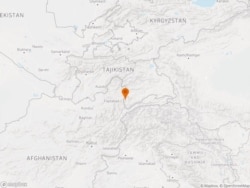Protests have ended in Tajikistan’s volatile Gorno-Badakhshan region after several hours of negotiations between government officials and representatives of the demonstrators on November 28, local residents told RFE/RL.
During the talks, the authorities pledged not to launch criminal probes against the protesters who had been staging demonstrations in front of the government building in the provincial capital, Khorugh, since November 25, said a local activist who attended the negotiations.
The activist spoke on condition of anonymity as they weren’t authorized to speak to media.
According to the source, the officials also promised to open an investigation into the death of a local man who was shot dead by police in an incident that sparked the four-day protests.
The protesters dispersed in the afternoon and the situation in the city have returned to normal, several Khorugh residents said. There was no immediate comment from government officials.
Earlier, police sources said that Gorno-Badakhshan's acting governor, Alisher Mirzonabot, and several other officials and lawmakers were negotiating with some 40 representatives of protesters in the governor’s office to end the tensions.

Protests in Khorugh broke out after security forces fatally wounded a local man wanted on charges of kidnapping. On November 25, protesters brought the dead body of the man, Gulbidin Ziyobekov, to the town’s main square, demanding an investigation into the incident.
Some in the crowd then attempted to seize the building of the regional administration using "firearms, stones, and sharp objects," wounding four members of the security forces and a staff member of the prosecutor's office, the state security service said in a statement.
In response, security forces fired on protesters, killing at least one person and wounding several others, sources told RFE/RL’s Tajik Service.
Violence continued in the following days. According to provincial prosecutors, protesters threw stones and wounded Aziz Ghiyoszoda, a member of parliament. That incident happened on November 27 when Ghiyoszoda along with the acting governor, Mirzonabot, came to the central square, unsuccessfully attempting to hold talks with the protesters.
Local residents say that up to 5,000 people were taking part in the rallies every day. However, the size of the demonstration on November 28 was considerably smaller with several dozen protesters gathered in front of the government headquarters.
Police also removed several checkpoints they had set up in the city after the tensions began.
Dismantling the checkpoints was among the protesters’ requests.
Protests are rare in the tightly-controlled nation of 9.5 million where President Emomali Rahmon has ruled for nearly three decades.
Tensions between the government and residents of the nominally autonomous Gorno-Badakhshan region have simmered ever since a five-year civil war broke out shortly after the collapse of the Soviet Union in 1991.
A linguistically and ethnically distinct region, Gorno-Badakhshan has been home to rebels who opposed government forces during the conflict.










